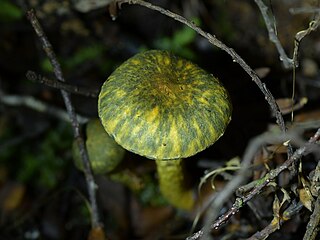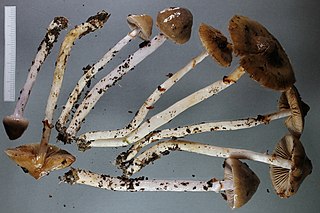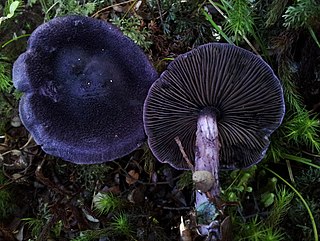
Cortinarius is a globally distributed genus of mushrooms in the family Cortinariaceae. It is suspected to be the largest genus of agarics, containing over 2,000 widespread species. A common feature among all species in the genus Cortinarius is that young specimens have a cortina (veil) between the cap and the stem, hence the name, meaning curtained. Most of the fibres of the cortina are ephemeral and will leave no trace once gone, except for limited remnants on the stem or cap edge in some species. All have a rusty brown spore print. The common names cortinar and webcap refer to members of the genus. Due to dangerous toxicity of several species and the fact that it is difficult to distinguish between various species of the genus, non-expert consumption of mushrooms from the genus is discouraged.

Cortinarius rotundisporus, also known as the elegant blue webcap, is a basidiomycete mushroom of the genus Cortinarius found in southern Australia, where it is found in eucalypt forests and rainforests. The cap of the fruit body is a steely blue colour, with a yellowish boss, and paler similarly coloured stipe.

Cortinarius violaceus, commonly known as the violet webcap or violet cort, is a fungus in the webcap genus Cortinarius native across the Northern Hemisphere. The fruit bodies are dark purple mushrooms with caps up to 15 cm (6 in) across, sporting gills underneath. The stalk measures 6 to 12 centimetres by 1 to 2 cm, sometimes with a thicker base. The dark flesh has a smell reminiscent of cedar wood. Forming symbiotic (ectomycorrhizal) relationships with the roots of various plant species, C. violaceus is found predominantly in conifer forests in North America and deciduous forests in Europe.

Cortinarius archeri is a species of mushroom in the genus Cortinarius native to Australia. The distinctive mushrooms have bright purple caps that glisten with slime, and appear in autumn in eucalypt forests.

Meinhard Michael Moser was an Austrian mycologist. His work principally concerned the taxonomy, chemistry, and toxicity of the gilled mushrooms (Agaricales), especially those of the genus Cortinarius, and the ecology of ectomycorrhizal relationships. His contributions to the Kleine Kryptogamenflora von Mitteleuropa series of mycological guidebooks were well regarded and widely used. In particular, his 1953 Blätter- und Bauchpilze [The Gilled and Gasteroid Fungi ], which became known as simply "Moser", saw several editions in both the original German and in translation. Other important works included a 1960 monograph on the genus Phlegmacium and a 1975 study of members of Cortinarius, Dermocybe, and Stephanopus in South America, co-authored with the mycologist Egon Horak.
Egon Horak is an Austrian mycologist who has described more than 1000 species of fungi, including many from the Southern Hemisphere, particularly New Zealand and South America. He was an executive editor of the scientific journal Sydowia from 1975 to 1989, and a member of the editorial board afterwards.

Cortinarius erythraeus, sometimes known as the Jammie Dodger, is a basidiomycete fungus of the genus Cortinarius native to Australia.
Cortinarius indolicus is a basidiomycete fungus of the genus Cortinarius native to New Zealand.
Cortinarius verecundus is a basidiomycete fungus of the genus Cortinarius native to New Caledonia, where it grows under Nothofagus.
Cortinarius viscoviridis is a basidiomycete fungus of the genus Cortinarius native to New Zealand, where it grows under Nothofagus and Leptospermum scoparium.

Cortinarius aerugineoconicus is a basidiomycete fungus of the genus Cortinarius native to New Zealand, where it grows under southern beech trees.

Cortinarius salor is a basidiomycete fungus of the genus Cortinarius native to Europe and Asia, spreading as far east as Japan and New Guinea. It is also found in conifer forests of the North American Pacific Northwest.
Cortinarius indigoverus is a basidiomycete fungus of the genus Cortinarius native to New Guinea, where it grows under Nothofagus.
Cortinarius microarcheri is a basidiomycete fungus of the genus Cortinarius native to South and Western Australia, where it grows under Eucalyptus.
Cortinarius taylorianus is a basidiomycete fungus of the genus Cortinarius native to New Zealand, where it grows under Nothofagus and produces an imposing purple mushroom. This species is named in honour of Grace Marie Taylor, a New Zealand fungi expert.

Cortinarius cucumeris is a basidiomycete fungus of the genus Cortinarius native to New Zealand, where it grows under Nothofagus.

Cortinarius atrolazulinus is a fungus native to New Zealand.
Cortinarius subcalyptrosporus is a fungus native to Borneo, where it was originally collected by E.J.H. Corner on the slopes of Mount Kinabalu in 1964 and described by Meinhard Michael Moser in 1986. Specimens from New Zealand classified as this species are Cortinarius kioloensis. It is poorly known.
Cortinarius atroviolaceus is a fungus native to Borneo, where it was originally collected by E.J.H. Corner on the slopes of Mount Kinabalu in 1964 and described by Meinhard Michael Moser in 1986. Specimens from New Zealand classified as this species are probably a different species. It is poorly known.








